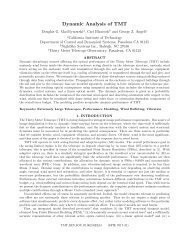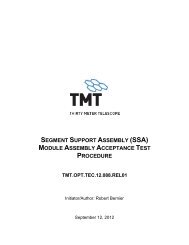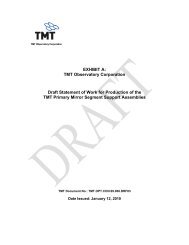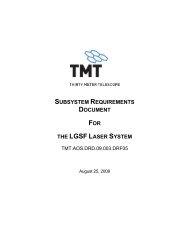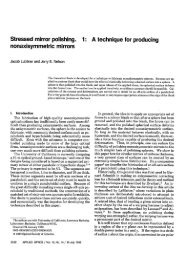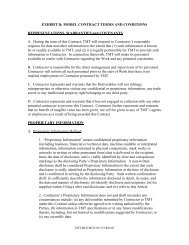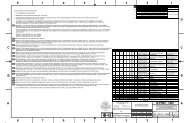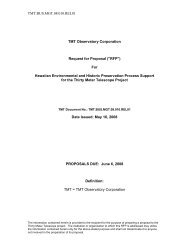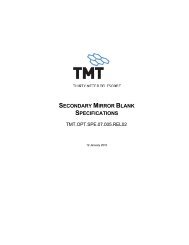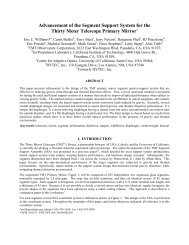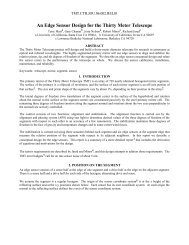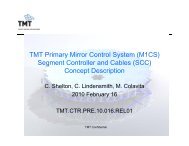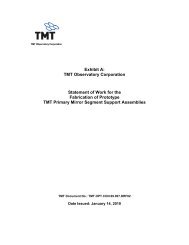TMT Construction Proposal - Thirty Meter Telescope
TMT Construction Proposal - Thirty Meter Telescope
TMT Construction Proposal - Thirty Meter Telescope
Create successful ePaper yourself
Turn your PDF publications into a flip-book with our unique Google optimized e-Paper software.
(a)<br />
(b)<br />
Fig 1-1: The telescope design (a), and the entire observatory system (b).<br />
<strong>TMT</strong> will couple unprecedented light collection area (almost 10 times more than one of the Keck telescopes)<br />
with diffraction-limited spatial resolution that exceeds by Keck by a factor of 3. Relative to the Hubble Space<br />
<strong>Telescope</strong> (arguable the most revolutionary astronomical instrument of our generation), <strong>TMT</strong> will have 144<br />
times the collecting area and more than a factor of 10 better spatial resolution at near-infrared and longer<br />
wavelengths.<br />
1.2.1 Aperture Size<br />
<strong>Telescope</strong> primary mirror (M1) diameter (aperture size) is a key design choice – it drives the size and<br />
complexity of almost every other observatory system. From a science perspective, we know that the<br />
observations limited by atmospheric turbulence improve in sensitivity as diameter squared (D 2 ). Furthermore,<br />
AO systems allow us to remove much of the effects of turbulence, achieve diffraction-limited imaging, and gain<br />
an improvement of D 4 . Hence, science gain motivates the largest diameter enabled by technology and cost.<br />
Technologically, large M1 diameters are enabled by using the precision-controlled, segmented mirror<br />
techniques pioneered with great success by the W. M. Keck Observatory. The <strong>TMT</strong> M1 design team includes<br />
many of the key developers of the Keck system. In principle, arbitrarily large mirrors are possible. However, our<br />
analysis of AO technology development over the next ten years with respect to our detailed science goals (as<br />
summarized in Chapter 2 of this proposal) suggests that D = 30 meters occupies an attractive and achievable<br />
scientific “sweet spot” at near-infrared wavelengths [2].<br />
Obviously, cost also limits M1 diameter – how does financial pressure affect choice of aperture size Prior to<br />
the design of the Keck telescopes, ground-based optical-IR telescope costs scaled roughly as D 2.7 , reflecting<br />
the nearly volumetric dependence of observatory cost on aperture [3,4]. The advent of thinner primary mirrors<br />
with shorter focal lengths, as in the Kecek design, reduced this relationship to an estimated D 2 ; i.e., varying as<br />
the area of the aperture. A detailed cost study of key <strong>TMT</strong> design parameters (aperture, segment count,<br />
segment size, segment thickness, and enclosure diameter) for several hundred estimated elements in <strong>TMT</strong><br />
concluded that <strong>TMT</strong> costs should scale as approximately D 1.15 relative to the Keck capital investment. Thus, we<br />
conclude that the <strong>TMT</strong> design represents an improved cost scaling and that the proposed 30 meter diameter of<br />
<strong>TMT</strong> represents a good value relative to the extraordinary science reach.<br />
1.2.2 Adaptive Optics<br />
Like all existing ground-based observatories, <strong>TMT</strong> will be capable of seeing-limited observations, i.e.<br />
observations with spatial resolution limited by the natural turbulence in the Earth’s atmosphere. Since such<br />
observations improve as D 2 , <strong>TMT</strong> will be able to observe objects nine times fainter than Keck in an equal<br />
amount of time.<br />
<strong>TMT</strong> <strong>Construction</strong> <strong>Proposal</strong> 2



